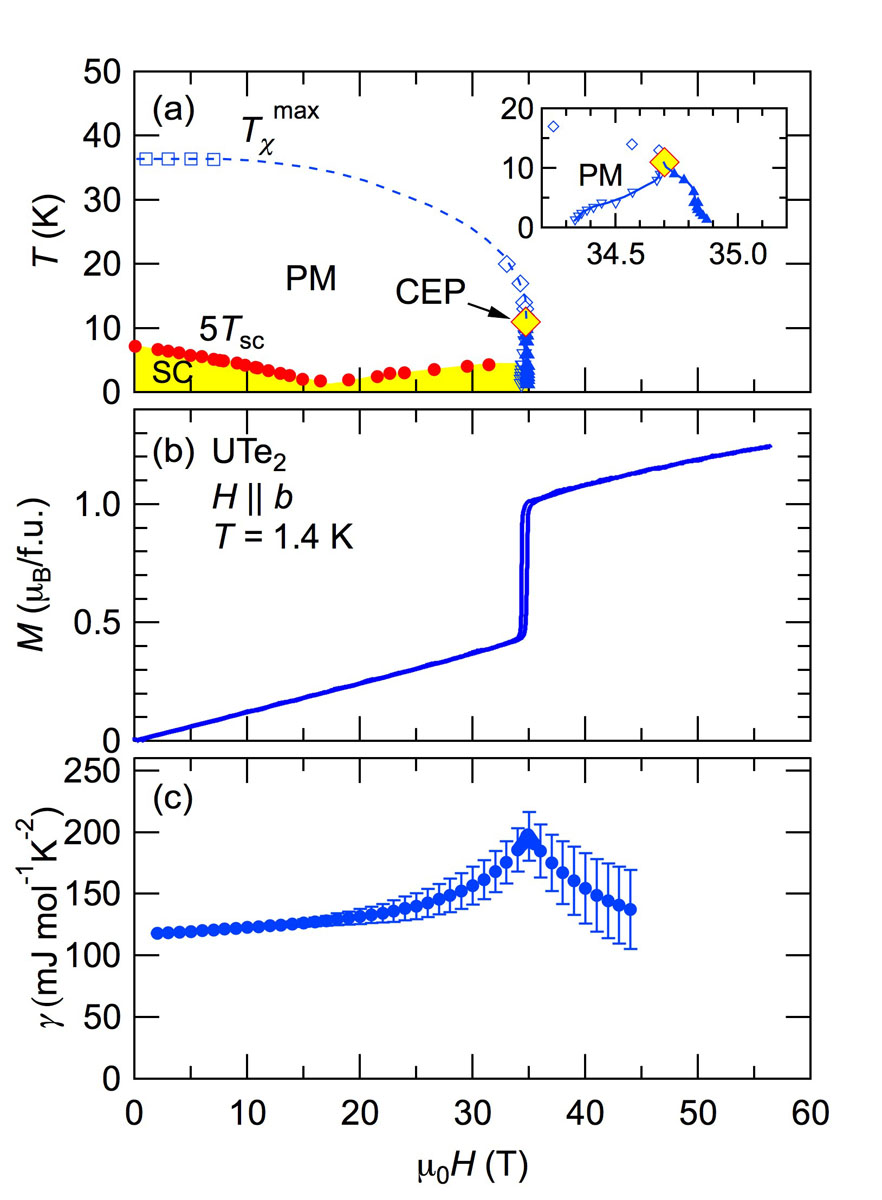Discovery of Metamagnetic Transition in New Unconventional Superconductor UTe2
Tokunaga Group
News of the discovery of unconventional superconductivity in a paramagnetic heavy-fermion system UTe2 at the end of 2018 has excited strongly the researchers working on the condensed matter physics. Within a few years since the first report in arXiv, many new aspects have been unveiled both experimentally and theoretically. One of the intriguing phenomena in UTe2 recognized in the very early stage is its large superconducting critical fields. For the magnetic fields applied along the hard magnetization b-axis, the superconducting transition can survive well above the Pauli paramagnetic limit [1,2]. This fact suggests the realization of the long-sought spin-triplet superconductivity. Such unconventional superconductivity is believed to realize in the ferromagnetic superconductors (FMSCs), such as URhGe and UCoGe. In the case of UTe2, however, the ground state is paramagnetic. Here, we introduce our observation of metamagnetic transition in UTe2 and discuss the relation between metamagnetism and superconductivity by compared to FMSCs [3].
The high-field magnetization was measured by using the pulse magnets installed in the International MegaGauss Science Laboratory. Figure 1(b) shows the magnetization curve for the field along the b axis at 1.4 K. At μ0Hm ~ 35 T, magnetization suddenly increases with a large step of ~0.6 μB. Because of the hysteric behavior against the magnetic field, this metamagnetic transition is of first-order. From the magnetization curves at various temperatures, we summarized a magnetic phase diagram of UTe2 in Fig. 1(a). The field hysteresis disappears above 11 K, indicating the existence of the critical end point (CEP), and the transition changes to crossover. As known in many paramagnets, the energy scale of metamagnetic transition, μ0Hm , corresponds to Tχmax, where the temperature dependence of magnetic susceptibility shows a broad maximum. This relation is further supported by the fact that μ0Hm (T) connects to Tχmax(μ0H). At almost the same time, the high-field magnetoresistance measurements independently revealed a similar phase diagram [4]. A sharp step-like increase in the resistance across the Hm may reflect the modification of the Fermi surface, although it is not clear yet. More interestingly, the superconducting (SC) phase shows a reentrant behavior above 16 T and is suddenly suppressed above μ0Hm [5] [see Fig. 1(a)]. This unusual Tc enhancement can be explained qualitatively by a simple mass-enhancement model as follows. Figure 1(c) represents the magnetic-field evolution of the electronic specific heat g, derived by the thermodynamic Maxwell relation using the temperature dependencies of magnetization at constant fields [3]. With increasing fields, the γ increases and shows a maximum at Hm. This enhancement is also confirmed by the direct specific heat measurement using a pulse magnet in ISSP [6]. This enhancement on going to metamagnetic transition indicates that the development of the fluctuation evolves around Hm. This fluctuation may stabilize the SC phase even at high magnetic fields as has been adapted to explain the reentrant superconductivity in URhGe. Using a simplified McMillan-type formula, the field-enhancement of the superconducting transition temperature can be reproduced qualitatively [see Refs. 3 and 6 for more detail and references therein].
Now, it is no doubt that the high-field studies make an important role to reveal the superconductivity on UTe2. Soon after our work [4], more exciting phenomena in high fields were reported [7]: Surprisingly, another SC phase appears at Hm when the field is applied intermediate angles between the a and c axis. This is in stark contrast to the fact of suppression of SC at Hm for the b axis. Our struggles continue.
References
- [1] S. Ran, C. Eckberg, Q.-P. Ding, Y. Furukawa, T. Metz, S. R. Saha, I.-L. Liu, M. Zic, H. Kim, J. Paglione, and N. P. Butch, Science 365, 684 (2019).
- [2] D. Aoki, A. Nakamura, F. Honda, D. X. Li, Y. Homma, Y. Shimizu, Y. J. Sato, G. Knebel, J.-P. Brison, A. Pourret, D. Braithwaite, G. Lapertot, Q. Niu, M. Vališka, H. Harima, and J. Flouquet, J. Phys. Soc. Jpn. 88, 043702 (2019).
- [3] A. Miyake, Y. Shimizu, Y. J. Sato, D. Li, A. Nakamura, Y. Homma, F. Honda, J. Flouquet, M. Tokunaga, and D. Aoki, J. Phys. Soc. Jpn. 88, 063706 (2019).
- [4] W. Knafo, M. Vališka, D. Braithwaite, G. Lapertot, G. Knebel, A. Pourret, J.-P. Brison, J. Flouquet, and D. Aoki, J. Phys. Soc. Jpn. 88, 063705 (2019).
- [5] G. Knebel, W. Knafo, A. Pourret, Q. Niu, M. Vališka, D. Braithwaite, G. Lapertot, M. Nardone, A. Zitouni, S. Mishra, I. Sheikin, G. Seyfarth, J.-P. Brison, D. Aoki, and J. Flouquet, J. Phys. Soc. Jpn. 88, 063707 (2019).
- [6] S. Imajo, Y. Kohama, A. Miyake, C. Dong, J. Flouquet, K. Kindo, and D. Aoki, J. Phys. Soc. Jpn. 88, 083705 (2019).
- [7] S. Ran, I.-L. Liu, Y. S. Eo, D. J. Campbell, P. Neves, W. T. Fuhrman, S. R. Saha, C. Eckberg, H. Kim, J. Paglione, D. Graf, J. Singleton, and N. P. Butch, Nat. Phys. 15, 1250 (2019).

